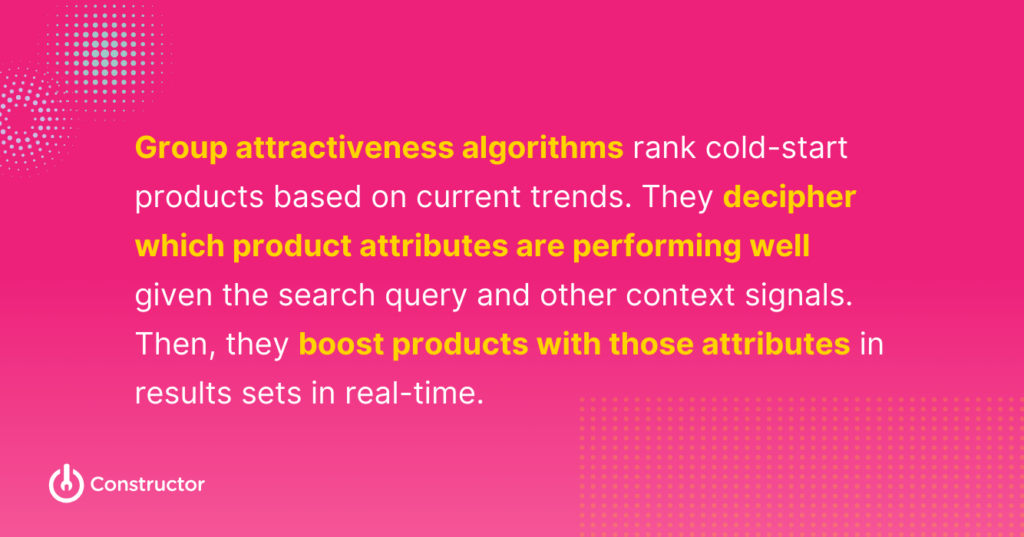This post was written in collaboration with Andrew Carcova, Director of Solutions Engineering at Constructor.
Have you ever wondered what happens with a new product that’s added to the catalog? Does it just get lost in the shuffle since there’s no customer behavioral data attached to it? It shouldn’t, provided you’re leveraging the right vendor.
Discover how Constructor uses true AI models and algorithms to tackle the infamous “cold-start product” problem and help ecommerce businesses hit timely KPIs.
About Cold-Start Products
Cold-start products are new products that have no behavioral clickstream data. Because they’re recently added to the product catalog, there are no clicks or customer interactions that provide cues as to how the products should be ranked.

The cold-start product problem is only native to product search and discovery vendors that use clickstream at its core for both recall and ranking. Competitors that don’t leverage clickstream solve for cold-start products with patchwork approaches.
They rely heavily on keyword matching and term frequency and layer in tie-breaking algorithms or try to rerank by best sellers. Or, they claim vectors are the future when in reality, they’re at least a decade old and don’t solve the issue at hand with accuracy.
Here at Constructor, we have a solution to the cold-start product issue that other vendors trip over. That’s because we care about what shoppers do after they search for a particular product, even those without behavioral data. How our search engine is powered reflects this.
How Constructor Ranks Cold-Start Products

Constructor’s Native Commerce Core™ is powered by advanced algorithms, transformers, and large language models (LLMs) with clickstream and behavior as critical signals. It collects and uses clickstream to ensure results are attractive to the user across their entire search and product discovery experience.
While behavioral data takes the front seat, there are several other core functionalities, algorithms, and models that come into play when ranking cold-start products:
Personal Attractiveness
The personal attractiveness algorithm revolves around ranking products in a way that’s more attractive to that specific user.
If a user searches for a “t-shirt,” what is that specific person going to click on and add to cart based on personal affinities? Thanks to clickstream, you already know they prefer a specific brand, fabric type, size, etc.
Using this personal affinity data with the new items introduced to the catalog, Constructor already knows what new items will be more favorable to each returning shopper. If a new item is introduced, and it shares elements that the shopper is quite keen on, Constructor will inherently leverage those personal signals to score a new item appropriately for each shopper.
Without understanding the clickstream, this analysis — and subsequent hyper-personalized product ranking — is impossible.
Group Attractiveness
Another layer of attractiveness that segues into cold-start products is group attractiveness, a core element to our product offering. It’s based on the overarching principle of ranking products according to conversions garnered from collective clickstream data.
In other words, when someone searches for a t-shirt, what features, attributes, and category groupings of t-shirts actually perform the best?
Here are a couple ways group attractiveness works and how scores are calculated:
Group attractiveness picks up on current trends
Group attractiveness algorithms decipher which product attributes are performing well given the search query and other context signals. Then, they boost products with those attributes in results sets in real-time.

For new t-shirts, attributes ranked could include v-neck, crew neck, long sleeve, crop top, and other important features. More people might search for long-sleeve shirts during the winter months, but short-sleeve t-shirts might be more popular in the spring and summer.
The AI dynamically surfaces and ranks products each time a search for “t-shirt” is performed based on group attractiveness scores. New (a.k.a. cold-start) products that share categories and/or attributes of items currently trending specific to each query will absorb the ranking impact captured from like products performing well.
It also leans on historically best-performing products
Aside from leveraging current trends, group attractiveness algorithms also rank cold-start products according to your ecommerce site’s historically best-performing items.
For example, if someone searches for “t-shirt,” and the new cold-start product has three of the top five best performing attributes (i.e., long-sleeve, v-neck, cotton), the new product will surface among the top in search results pages.
Competitors that blindly rerank results with a best-selling boost will keep the new cold items on ice. (The self-fulfilling prophecy has never been more evident when using this approach.)
They also boost best-selling products across their entire ecommerce site in more prominent search results positions — absent marketing campaigns, who the user is, seasonality trends, etc. As in, they don’t stop to consider that top sellers can vary across your site. What’s selling best when shoppers search for the product may not be for those browsing or those who happen across it in Collections pages.
Core AI Functionalities, Models, and Algorithms
Our Native Commerce Core™ leverages several other functionalities, models, and algorithms to rank cold-start products, including — but not limited to:
Cognitive Embeddings Search (CES)
Cognitive Embeddings Search (CES) is an n-dimensional representation of products, product attributes, queries, categories, clickstream, and much more that is native to the Constructor platform. Unlike other vector add-ons, it leverages clickstream to ensure products returned are actually attractive to users, surfacing products for zero results searches.
It’s been proven to reduce search reformulations by +20%.
Genetics Algorithms
Genetics Algorithms are a core competency of our product search and discovery solution that date back to genetics theory, where you accept or deny mutations in order to evolve into a superior state.
In this approach, we use statistical significance — based on CES, group attractiveness, and other factors — to determine if an item or subset of items will perform well. From there, we subtly boost them in the results set and let shoppers confirm or deny this “mutation.”
If no shopper clicks on the boosted products, it’s a “bad mutation,” and the products drop in rankings. If shoppers click on them and ultimately convert, that’s an indication that it’s a “healthy mutation,” and the products are accepted in the new positions. (As a test-first organization, opening this feedback loop is critical.)
LambdaRank
LambdaRank is another core competency of our product search and discovery solution.
This Learning to Rank method is a machine learning (ML) ranking method that further enhances the ranking of search results or recommendations in results sets by empowering each item to battle the item that precedes it to create an ideal ranking order.
To visualize this, think of them as a series of matches in a sports tournament, where one winner advances to each next round.
How All of This Lends to Business Success
We leverage all of these core functionalities, models, and algorithms with one end goal in mind: solve for ecommerce KPIs.
Truly personalized experiences powered by AI-native solutions get the right products — whether new or not — in front of your customers at the right time, layering the business metrics that matter most to you on top.
The results? A product search and discovery experience that reduces the manual workload of your merchandising team, streamlines the customer shopping experience, and increases customer satisfaction — along with your bottom line.
Learn how an AI-first engine can help you return the best result sets of new and existing products to hit important business metrics.

